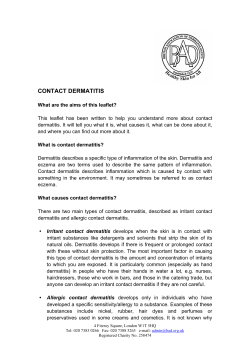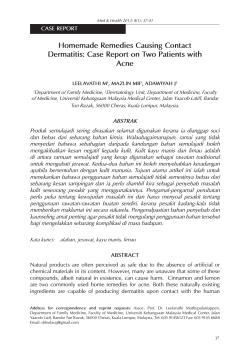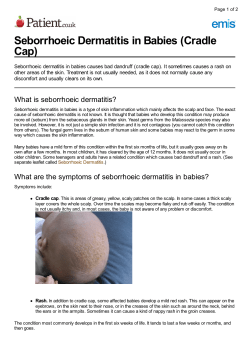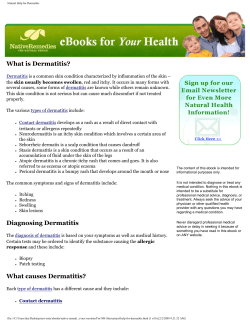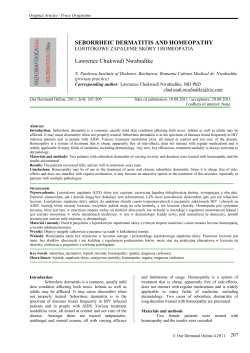
Preventing contact dermatitis at work
Health and Safety Executive Preventing contact dermatitis at work Health and Safety Executive Preventing contact dermatitis at work This leaflet tells you about a skin problem that you can get at work – contact dermatitis. If you are an employer, safety representative, trainer or safety advisor you can influence work practice and prevent this disabling disease. The leaflet shows you what to look out for and how to prevent dermatitis. It also tells you where you can find more detailed practical advice for specific jobs and workplaces. What is contact dermatitis? This is a web-friendly version of leaflet INDG233(rev1), revised 03/07 Contact dermatitis is inflammation of the skin caused by contact with a range of materials. These include detergents, toiletries, chemicals and even natural products like foods and water (if contact is prolonged or frequent). It can affect all parts of the body, but it is most common to see the hands affected. There are three main types of contact dermatitis: ■ ■ ■ irritant contact dermatitis: allergic contact dermatitis: contact urticaria. Irritant contact dermatitis is caused by things that dry out and damage the skin, eg detergents, solvents, oils and prolonged or frequent contact with water. Allergic contact dermatitis occurs when someone becomes allergic to something that comes into contact with his or her skin. The allergic reaction can show up hours or days after contact. Common causes include chemicals in cement, hair products, epoxy resins and some foods. Urticaria is a different kind of allergy. It occurs within minutes of the material touching the skin. Things like plants, foods and natural rubber latex gloves can cause it. What does contact dermatitis look like? The signs and symptoms of the different types of dermatitis are similar. Dry, red and itchy skin is usually the first sign. Swelling, flaking, blistering, cracking and pain can follow. Sometimes the consequences of contact with a material are immediately visible. Sometimes contact occurs without apparent effect. However, every contact can cause minute amounts of ‘invisible’ damage to the skin that can build up until more serious signs are seen. So, don’t be lulled into a false sense of security. 1 of 3 pages Health and Safety Executive What are the high-risk jobs and workplaces? Certain workers are at greater risk of developing dermatitis. They include healthcare workers, hairdressers, beauticians, printers, those in cleaning, catering and construction and workers using metalworking fluids. But remember, dermatitis can occur in just about any workplace. Managing the work to prevent dermatitis Following three simple steps can prevent dermatitis: Avoid contact with materials that cause dermatitis. Protect the skin. Check for early signs of dermatitis. No contact = no dermatitis. So take all the steps you can to avoid contact with materials that cause dermatitis by changing the task or process. Some examples of how you can do this are given below. Examples of how you can avoid contact are: ✖ ✔ ■ ■ ■ ■ ■ ■ ■ substitute a more hazardous material with a safer alternative; automate the process; enclose the process as much as possible; use mechanical handling; use equipment for handling; don’t use the hands as tools; use a safe working distance. You will also need to protect the skin. This is particularly important if the steps above aren’t practical or aren’t enough to totally avoid contact. ✖ ✔ You can protect the skin by the following: ■ ■ ■ ■ ■ ■ ■ ■ ■ ■ tell workers how to look after their skin; remind them to wash any contamination from their skin promptly; tell them about the importance of thorough drying after washing; provide soft cotton or paper towels; supply moisturising pre-work and after-work creams; provide appropriate protective clothing/gloves; make sure gloves are made of suitable material; select gloves that are the right size and right for the task to be done; use and store gloves correctly; replace gloves when necessary. You will also need to make sure regular skin checks are carried out to look for early signs of dermatitis. ■ ■ ■ ■ Regular skin checks can spot the early stages of dermatitis. Early detection can prevent more serious dermatitis from developing. Steps can be taken to start treating the condition. Checks can help indicate a possible lapse in your preventative measures and the need to reassess the situation. Preventing contact dermatitis at work 2 of 3 pages Health and Safety Executive What does the law require? The law requires employers to adequately control exposure to materials in the workplace that cause ill health like dermatitis. Employers and employees need to comply with the Control of Substances Hazardous to Health Regulations 2002 (as amended) (COSHH). They require employers to assess risks, provide adequate control measures, ensure the use and maintenance of these; provide information, instruction and training; and in appropriate cases, health surveillance. Where can I get more detailed information on the topics outlined? Skin disease Skin diseases, preventing skin disease, legislation and other control information: www.hse.gov.uk/skin, www.bsif.co.uk Catering HSE are developing catering web pages during 2007 Construction General construction information: www.hse.gov.uk/construction Hairdressing Good practice advice: www.badhandday.hse.gov.uk Printing Good practice advice: www.hse.gov.uk/printing/dermatitis Further information For information about health and safety, or to report inconsistencies or inaccuracies in this guidance, visit www.hse.gov.uk/. You can view HSE guidance online and order priced publications from the website. HSE priced publications are also available from bookshops. This leaflet contains notes on good practice which are not compulsory but which you may find helpful in considering what you need to do. This leaflet is available in priced packs of 15 from HSE Books, ISBN 978 0 7176 6183 1. Single copies are free and a web version can be found at: www.hse.gov.uk/pubns/indg233.pdf. © Crown copyright If you wish to reuse this information visit www.hse.gov.uk/copyright.htm for details. First published 03/07. Published by the Health and Safety Executive INDG233(rev1) 09/11 3 of 3 pages
© Copyright 2025



